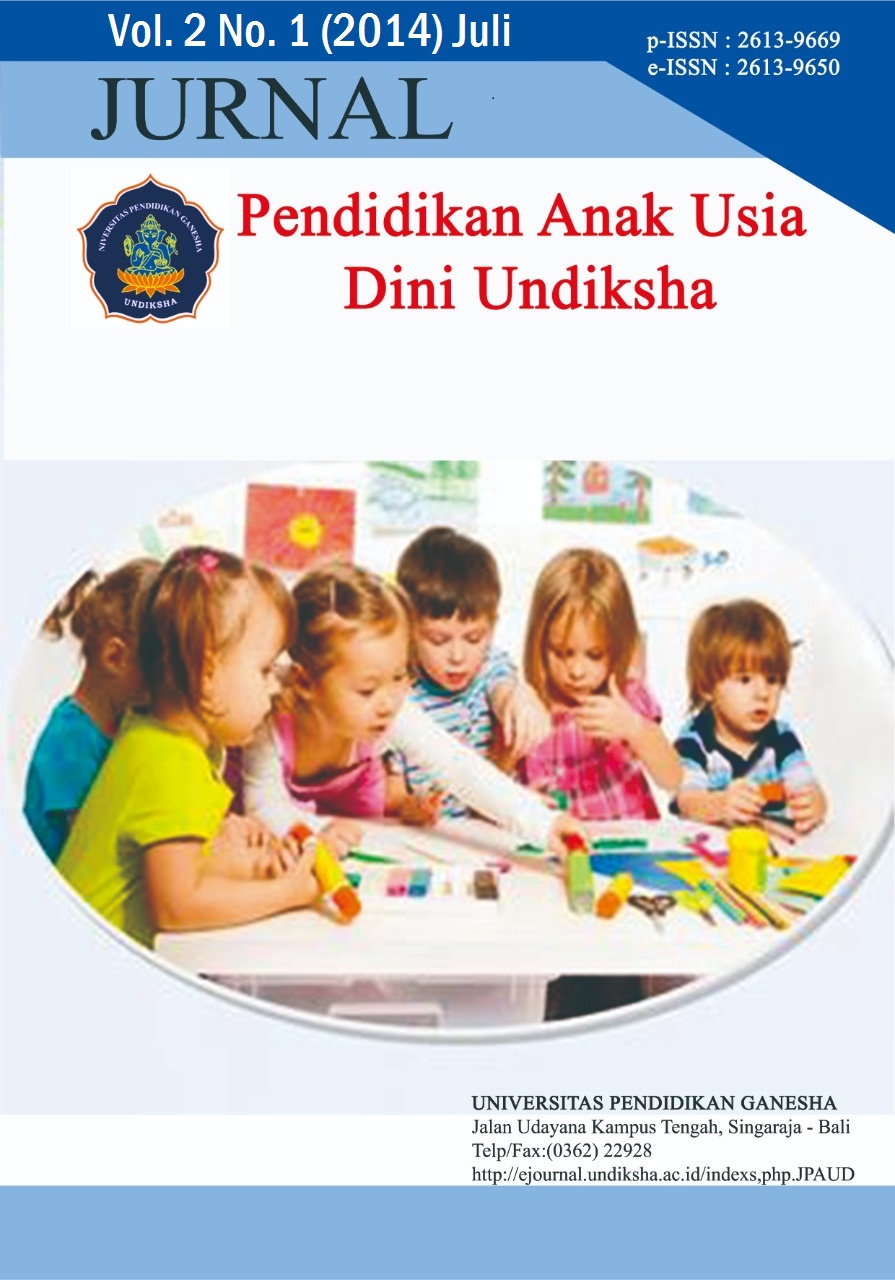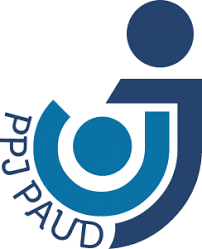PENERAPAN METODE BERMAIN BERBANTUAN MEDIA TELEPON GELAS UNTUK MENINGKATKAN PERKEMBANGAN BAHASA
DOI:
https://doi.org/10.23887/paud.v2i1.2991Abstract
Permasalahan yang terdapat pada penelitian ini mengenai rendahnya perkembangan bahasa dalam kemampuan berbicara. Penelitian ini bertujuan untuk mengetahui peningkatan perkembangan bahasa dalam kemampuan berbicara setelah diterapkan metode bermain berbantuan media telepon gelas pada anak kelompok B semester II Tahun Pelajaran 2013/2014 di TK Pra Widya Dharma Satra Kecamatan Kintamani Kabupaten Bangli.Jenis penelitian ini adalah penelitian tindakan kelas yang dilaksanakan dalam dua siklus. Subjek penelitian ini adalah 15 orang anak TK pada Kelompok B Semester II Tahun Pelajaran 2013/2014. Data penelitian tentang perkembangan bahasa dalam kemampuan berbicara dikumpulkan dengan metode observasi dan instrumen berupa lembar observasi. Data hasil penelitian dianalisis dengan menggunakan metode analisis statistik deskriptif dan metode analisis deskriptif kuantitatif.Hasil analisis data menunjukkan bahwa terjadi peningkatan perkembangan bahasa dalam kemampuan berbicara dengan penerapan metode bermain pada siklus I sebesar 70,30% yang berada pada kategori sedang ternyata mengalami peningkatan pada siklus II menjadi 84,65% yang tergolong pada kategori tinggi. Jadi, terdapat peningkatan perkembangan bahasa dalam kemampuan berbicara pada anak setelah diterapkan metode bermain berbantuan media telepon gelas sebesar 14,35%.Kata Kunci : metode bermain, media telepon gelas, perkembangan bahasa
The problems of this study regarded the lack of language development in speaking ability.The purpose of this research was to know the improvement on language development in speaking ability after using the application of playing method with the glasses phones media to the B group children the second semester or the academic year 2013/2014 in TK Pra Widya Dharma Satra district of Kintamani Bangli Regency. The type of study was a classroom action-based research which was carried out in two cycles with 15 children as the subjects of the second semester or the academic 2013/2014. The data on language development in speaking ability were collected by observation method with observation as the instrument. The data in this study were analyzed by using descriptive statistical analysis method and quantitative descriptive analysis method. The result of the data analysis showed 70,30% improvement for the language development in speaking ability with the application of playing method in the first cycle, which can be categorized as average. For the second cycle also became 84,65% improvement which can be categorized as high. Therefore, for the language development in speaking ability improved by using glasses phones media there was 13,35% improvement.
keyword : playing method, glasses phones media, language development
Published
2014-06-15
How to Cite
., N. P. S., ., D. N. W., & ., I. G. W. S. S. S. M. (2014). PENERAPAN METODE BERMAIN BERBANTUAN MEDIA TELEPON GELAS UNTUK MENINGKATKAN PERKEMBANGAN BAHASA . Jurnal Pendidikan Anak Usia Dini Undiksha, 2(1). https://doi.org/10.23887/paud.v2i1.2991
Issue
Section
Articles
License
Authors who publish with the Jurnal Pendidikan Anak Usia Dini Undiksha agree to the following terms:
- Authors retain copyright and grant the journal the right of first publication with the work simultaneously licensed under a Creative Commons Attribution License (CC BY-SA 4.0) that allows others to share the work with an acknowledgment of the work's authorship and initial publication in this journal.
- Authors are able to enter into separate, additional contractual arrangements for the non-exclusive distribution of the journal's published version of the work (e.g., post it to an institutional repository or publish it in a book), with an acknowledgment of its initial publication in this journal.
- Authors are permitted and encouraged to post their work online (e.g., in institutional repositories or on their website) prior to and during the submission process, as it can lead to productive exchanges, as well as earlier and greater citation of published work. (See The Effect of Open Access)











